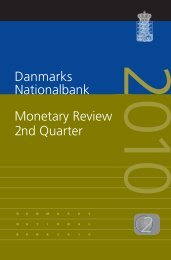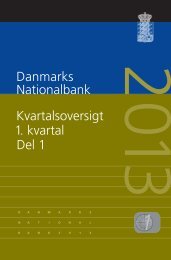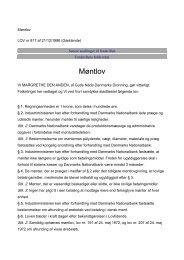SCP – Scandinavian Cash Pool - Den Kgl. Mønt
SCP – Scandinavian Cash Pool - Den Kgl. Mønt
SCP – Scandinavian Cash Pool - Den Kgl. Mønt
Create successful ePaper yourself
Turn your PDF publications into a flip-book with our unique Google optimized e-Paper software.
23<br />
<strong>SCP</strong> <strong>–</strong> <strong>Scandinavian</strong> <strong>Cash</strong> <strong>Pool</strong><br />
<strong>SCP</strong> is an automated system for the pledging of cross-border collateral<br />
between <strong>Den</strong>mark, Norway and Sweden. The system was developed in<br />
order to facilitate the <strong>Scandinavian</strong> CLS 1 participants' access to intraday<br />
liquidity in the <strong>Scandinavian</strong> currencies.<br />
The main principle of <strong>SCP</strong> is that liquidity raised at the central bank of<br />
one country may be pledged as collateral for loans from the central<br />
bank of another country. The participant pledges collateral at the national<br />
central bank by transferring liquidity to a special account that is<br />
pledged to the foreign central bank. The latter is notified automatically<br />
of the pledged amount and on that basis grants credit to the participant.<br />
When the participant has repaid the loan to the foreign central<br />
bank, the national central bank is informed automatically that the collateral<br />
may be released, i.e. the amount on the pledged account is<br />
automatically transferred back to the participant's current account. <strong>SCP</strong><br />
may only be used to pledge collateral for intraday credit. 2<br />
<strong>SCP</strong> is based on existing structures and systems. The liquidity is raised<br />
at the national central bank according to national procedures and<br />
within national systems. The liquidity is pledged to the foreign central<br />
bank via an ordinary transfer between accounts in the national RTGS<br />
system. The communication between the central banks is automated<br />
and based on existing standards (SWIFT). This structure ensures that<br />
cross-border collateral can be pledged via <strong>SCP</strong> in less than one minute.<br />
BACKGROUND TO AND USE OF <strong>SCP</strong><br />
The <strong>Scandinavian</strong> currencies became part of CLS in September 2003. As a<br />
consequence the requirements of the participants' procurement of liquidity<br />
in these currencies have been expanded. Moreover, three of the<br />
<strong>Scandinavian</strong> participants have made a commitment to contribute to the<br />
CLS Liquidity Facilities in all three currencies, which means that they<br />
must be able to raise large amounts in one or several of the Scandin-<br />
1<br />
2<br />
CLS (Continuous Linked Settlement) is an international foreign-exchange settlement system. For<br />
further information, see Financial Stability, 2003 page 97.<br />
For further information on <strong>SCP</strong> reference is made to www.nationalbanken.dk under Tasks/Payment<br />
systems/Collateral. For a description of the legal basis for <strong>SCP</strong>, see Niels C. Andersen and Kirsten Gürtler,<br />
The Provision of Collateral to Danmarks Nationalbank in a Legal Perspective, Danmarks Nationalbank,<br />
Monetary Review, 3rd Quarter 2003.
24<br />
avian currencies at short notice. CLS is the primary reason for the establishment<br />
of <strong>SCP</strong>.<br />
However, the use of <strong>SCP</strong> is not limited to CLS purposes, and the system<br />
is open to other than the CLS banks. For instance, <strong>SCP</strong> will make it possible<br />
for banks with activities in more than one <strong>Scandinavian</strong> country to<br />
centralise the pledging of collateral and liquidity management in one<br />
country and nonetheless still cover their intraday liquidity requirements<br />
in the two other countries.<br />
Today four of the five <strong>Scandinavian</strong> CLS participants also participate in<br />
<strong>SCP</strong>. During the first month after the <strong>Scandinavian</strong> currencies became<br />
part of CLS, SPC was primarily used to pledge collateral in <strong>Den</strong>mark in<br />
order to obtain intraday liquidity in Norway and Sweden. The explanation<br />
may be that the participants primarily hold their collateral in <strong>Den</strong>mark,<br />
or that the payments to CLS are relatively larger in Sweden and<br />
Norway compared to the liquidity available in the country in question.<br />
FOCUS ON CROSS-BORDER PLEDGING OF COLLATERAL<br />
The establishment of CLS has generally increased focus on the possibility<br />
of pledging cross-border collateral. Particularly the large international<br />
banks are motivated by other factors besides CLS to require easier access<br />
to cross-border intraday liquidity. In March 2003 a task force under The<br />
Payments Risk Committee set up by the Federal Reserve Bank of New<br />
York with participants from 13 large international banks published a<br />
report on cross-border pledging of collateral and access to intraday<br />
liquidity. 1<br />
According to the report, the need for cross-border intraday liquidity is<br />
increasing. The internationalisation of the financial markets entails that<br />
banks increasingly operate beyond their domestic markets. The banks<br />
represented in the task force state that around half their payment activities<br />
take place in foreign markets, and therefore they require crossborder<br />
liquidity. Over the years payment and settlement systems have<br />
moreover been introduced which in many ways enhance the overall<br />
security of the financial system, but which also make higher demands of<br />
the participants' liquidity procurement. CLS is only the most recent<br />
example.<br />
The task force recommends that the central banks for the CLS currencies<br />
to a larger extent accept securities denominated in foreign currencies<br />
as collateral for intraday liquidity. In addition, the task force set<br />
1<br />
The Payments Risk Committee, Report by the Cross-border Collateral <strong>Pool</strong> Task Force, Managing<br />
Payment Liquidity in Global Markets: Risk Issues and Solutions.
25<br />
MODELS FOR PLEDGING CROSS-BORDER COLLATERAL<br />
Box<br />
In the Risk Committee's report the proposed facilities for pledging cross-border collateral<br />
are collectively referred to as Cross-border Collateral <strong>Pool</strong> Facilities. Three basic<br />
models are described. For two of them different options are presented:<br />
• Securities Collateral <strong>Pool</strong>: In this model, market participants would be able to utilise<br />
foreign securities as collateral for intraday credit at a central bank. The report recommends<br />
an option where all central banks open custodian accounts with one or<br />
perhaps two international central securities depositories (CSDs). A bank requesting<br />
credit in a given currency transfers securities to the account of the relevant central<br />
bank. The CSD notifies the central bank that securities have been pledged as collateral,<br />
after which the central bank grants the credit.<br />
• <strong>Cash</strong> Collateral <strong>Pool</strong>: In this model, market participants would be able to pledge<br />
foreign currency to a central bank as collateral for intraday credit. One option entails<br />
that all central banks open accounts with each other. A bank wishing to pledge<br />
collateral in e.g. US dollars and obtain intraday credit in e.g. pounds sterling, transfers<br />
dollars to the Bank of England's account at the Federal Reserve Bank. Against<br />
collateral in this deposit the Bank of England provides credit in sterling. A drawback<br />
of the <strong>Cash</strong> model is that it cannot be used if one of the central banks is closed.<br />
• Central Bank Guarantee Model: This model is based on the central banks guaranteeing<br />
each other that collateral has been pledged, either as securities or cash.<br />
When a bank has transferred the collateral to a special guarantee account at a central<br />
bank, the central bank granting the intraday credit is notified. This model also<br />
requires that the central banks are open at the same time.<br />
The overall recommendation in the report is the establishment of a Securities Collateral<br />
<strong>Pool</strong>. Securities and CSDs are well-known elements of the existing arrangements<br />
for pledging collateral to central banks, and the model functions across time zones.<br />
<strong>SCP</strong> is a combination of elements from the <strong>Cash</strong> Collateral Model and the Central<br />
Bank Guarantee Model.<br />
out a number of models for how the central banks might build up an<br />
infrastructure for the pledging of cross-border collateral. The models are<br />
described in the Box.<br />
On the basis of the report, the opportunities and requirements for facilitating<br />
access to cross-border liquidity are being discussed among the<br />
central banks. It is clear that in the first instance the need for a facility<br />
for pledging cross-border collateral is greatest among the large international<br />
players participating in payment settlement in the USA, Europe<br />
and Asia. On the other hand, easier access to cross-border intraday<br />
liquidity may serve as an incentive to smaller banks to increase their<br />
international activities.
















